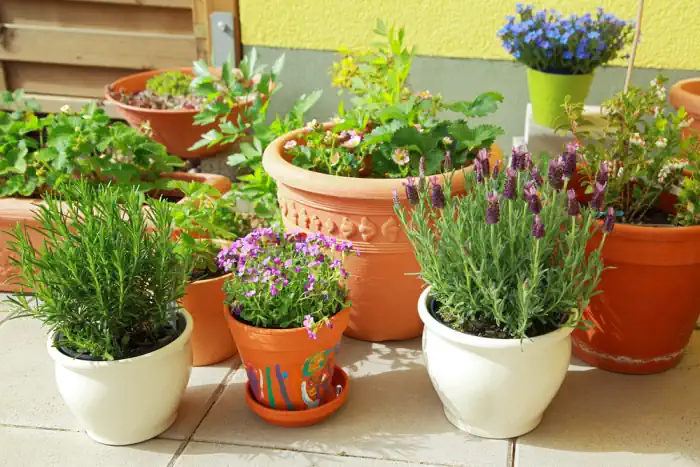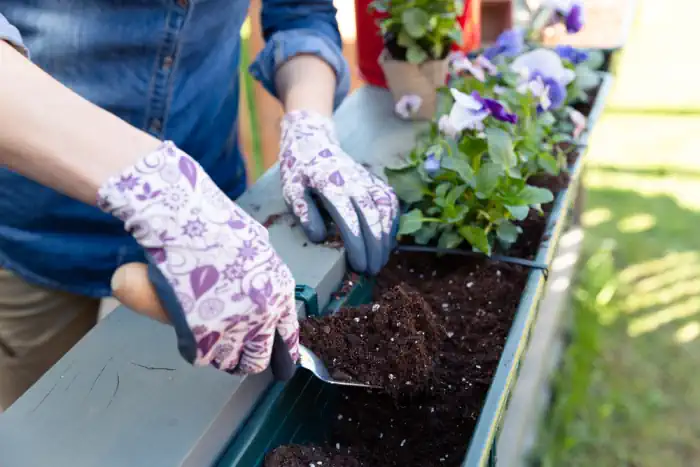Since the start of the Covid pandemic, the prices of vegetables and herbs have significantly increased, causing financial strain for many consumers. Additionally, when purchasing these items at a grocery store, they often come packaged in plastic or other waste-making containers, and may have been treated with toxic pesticides.

However, there is a solution that can help save money, improve health, and protect the environment: balcony gardening. With a balcony garden, you have the opportunity to grow your own fresh and chemical-free produce, as well as beautify your outdoor space, even if you don’t have a traditional garden.”
What You Need to Get Started
Starting a balcony garden is simple and only requires a few key items: a balcony, pots or containers, soil and plants. With these basic elements, you can begin cultivating your own green space and enjoying the benefits of gardening.
As your plants grow, you will need a few basic tools such as a garden fork, a small hoe, a watering can, pruners, and possibly gloves and an apron.
Planning Your Balcony Garden
Before starting your balcony garden, it’s important to assess the conditions on your balcony. The type of plants you choose for your balcony garden, whether vegetables, herbs, or flowers, will depend on the specific conditions of your outdoor space. Consider the amount of sunlight, temperature, and wind your balcony receives, as these factors will impact which plants will thrive.
For example, some vegetables require full sun to grow, while others prefer partial shade. Similarly, some plants are more sensitive to wind and may need extra watering in a windy location. By taking these factors into account, you can select plants that are well-suited to the conditions on your balcony.
Clear Your Space
To create the best space for your balcony garden, it can be helpful to remove any unnecessary items from your balcony. This can include furniture that you no longer use, such as an old chair or table, as well as items that are only used occasionally, like a grill or outdoor sports equipment. Removing these items will help free up space for your garden, creating a more cohesive and visually appealing outdoor area.
Additionally, by decluttering your balcony, you may find that it becomes a more enjoyable and relaxing space to spend time in. Once you have your garden set up, you can add a chair or other seating back in to help you enjoy your new outdoor space.
Selecting Containers and Pots for Your Balcony Garden
When choosing containers and pots for your balcony garden, it is important to consider the amount of space available for your plants to grow. Larger pots and containers will provide more room for the roots to spread, but be mindful of the weight and stability of the containers, as well as the weight-bearing capacity of your balcony.
Terracotta pots can be attractive, but they are also heavy and may not be practical for use on a balcony. Alternatively, you can consider using plastic pots or containers, which are lighter in weight.

There are many different types of pots and containers available, including hanging pots, wall-mounted racks, and pots that can be placed on the floor or on a plate. You can even find pots designed to hang from the roof of your balcony, which are ideal for light-weight plants like strawberries.
When selecting containers and pots, consider the specific needs and characteristics of the plants you are growing, as well as the layout and design of your balcony.
Choosing Your Soil
Once you have your containers and pots ready, it’s time to start gardening. Begin by choosing the right soil for your plants. While it may be tempting to use garden soil, it is not suitable for use in pots as it becomes too compacted and can restrict the flow of air and water to the roots. Instead, opt for a potting mix specifically designed for use in containers. Some plants may have specific soil requirements, such as a preference for acidic or basic soil, so be sure to research the needs of your chosen plants.
Seeds or Seedlings?
There are two ways to begin your garden: with seeds or with seedlings. While starting with seeds can be more economical, it may take longer for your plants to mature and produce a harvest. Some plants, such as leeks and strawberries, may take a full year to mature and produce a harvest.
Seedlings, on the other hand, can be planted immediately and will typically produce a faster result. Consider the growth rate and maturity of the plants you are interested in to determine the best option for your garden.
You can also check the information on seed packets to see the estimated time it will take for the plants to mature, and use this information to decide whether seeds or seedlings are the better choice for your garden.
Caring For Your Garden
Pay attention to the specific needs of your plants, as some may be more sensitive to over-watering or drought. Keep an eye out for signs of disease or pests, and use eco-friendly methods to address these issues, particularly if you are growing edible plants.
After your first harvest, you can take your balcony gardening to the next level by saving seeds from your own plants to use in future crops. This can be a fun and rewarding way to further customize and sustain your garden. Overall, a balcony garden can bring joy and relaxation, as well as the opportunity to enjoy the fruits of your labor in a beautiful outdoor space.

A balcony garden can provide endless hours of enjoyment and relaxation. Caring for your plants and creating a beautiful outdoor space can be soothing for the mind. If you have enough space on your balcony, you can sit and enjoy the fruits of your labor, just as you would in a traditional garden. Additionally, by starting and growing your own crops and flowers, you can become self-sufficient and independent. Overall, there are many upsides to having a balcony garden, and no real downsides.
In conclusion, balcony gardening is a fulfilling and rewarding hobby that can provide numerous benefits. By choosing the right soil, seeds or seedlings, and plants for your balcony’s conditions, you can create a thriving and beautiful garden. With the right tools and care, your balcony garden can provide fresh, chemical-free produce, as well as a peaceful and relaxing outdoor space. Whether you are a seasoned gardener or new to the hobby, a balcony garden is a rewarding and enjoyable pursuit.